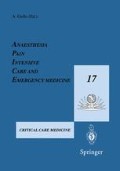Abstract
In European countries, trauma remains the commonest cause of death below the age of 40 years. Annual European deaths from road traffic accidents alone exceed 50,000 [1], with approximately 10 times this number being seriously injured. Despite various European safety campaigns, there is little to suggest that trauma deaths, particularly those from road traffic accidents, are declining in frequency. As life expectancy increases, the lifetime risk of an individual being involved in a serious accident increases further. Trauma patients will continue to place large demands on health resources, in terms of both acute management and the long-term rehabilitation of survivors.
Access this chapter
Tax calculation will be finalised at checkout
Purchases are for personal use only
Preview
Unable to display preview. Download preview PDF.
References
Cloag D (1993) Europe needs more road safety. BMJ 306:165
American College of Surgeons (1997) Advanced Trauma Life Support Course Manual, 6th edn.
Lockey D, Davies G, Coats T (2001) Survival of trauma patients who have prehospital tracheal intubation without anaesthesia or muscle relaxants: observational smdy. BMJ 323:141
Davies G, Deakin C, Wilson A (1996) The effect of a rigid collar on intracranial pressure. Injury 27:647–649
Britten S, Palmer S (1996) Chest wall thickness may limit adequate drainage of tension pneumothorax by needle thoracocentesis. J Accid Emerg Med 13:426–427
Eckstein M, Suyehara D (1998) Needle thoracostomy in the prehospital setting. Prehosp Emerg Care 2:132–135
Deakin C, Davies G, Wilson A (1995) Simple thoracostomy avoids chest drain insertion in prehospital trauma. J Trauma 39:373–374
Deakin C, Low J (2000) Accuracy of the advanced trauma life support guidelines for predicting systolic blood pressure using carotid, femoral, and radial pulses: observational study. BMJ 16:673–674
Alderson P, Schierhout G, Roberts I, et al (2002) Colloids versus crystalloids for fluid resuscitation in critically ill patients (Cochrane Review). In: The Cochrane Library, Issue 2. Update Software, Oxford
Kreimeier U, Messmer K (2002) Small-volume resuscitation: from experimental evidence to clinical routine. Advantages and disadvantages of hypertonic solutions. Acta Anaesthesiol Scand 46:625–638
Dutton R, Mackenzie C, Scalea T (2002) Hypotensive resuscitation during active hemorrhage: impact on in-hospital mortahty. J Trauma 52:1141–1146
Editor information
Editors and Affiliations
Rights and permissions
Copyright information
© 2003 Springer-Verlag Italia
About this paper
Cite this paper
Deakin, C.D. (2003). Early assessment of multiple trauma. In: Gullo, A. (eds) Anaesthesia, Pain, Intensive Care and Emergency Medicine — A.P.I.C.E.. Springer, Milano. https://doi.org/10.1007/978-88-470-2215-7_32
Download citation
DOI: https://doi.org/10.1007/978-88-470-2215-7_32
Publisher Name: Springer, Milano
Print ISBN: 978-88-470-0194-7
Online ISBN: 978-88-470-2215-7
eBook Packages: Springer Book Archive

